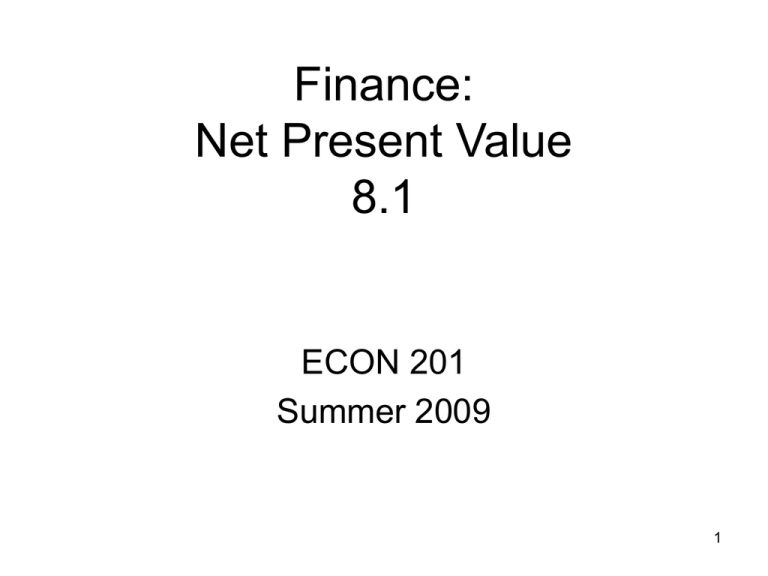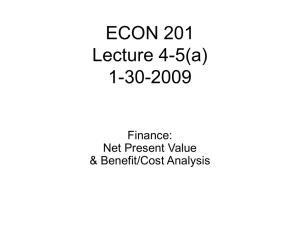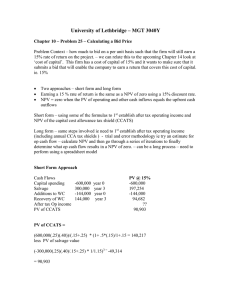Finance: Net Present Value 8.1 ECON 201
advertisement

Finance: Net Present Value 8.1 ECON 201 Summer 2009 1 Firm’s Financing Decision • Firm’s desire to expand and purchase new capital stock can be financed by: – Loan (repay with interest) • Borrow $X from a lending institution (bank) – Issue bonds (debt) • Promise to pay back bond holders later for obtaining $X today – Sell stock (corporate holdings, stock splits) • Decrease stock price in the short-run – Venture Capital 2 Benefit/Cost Analysis • Basic Issue in Business or Personal Finance Decisions – How to evaluate projects/investment opportunities that have a flow of benefits and costs over time • Approach – Stream of benefits and costs are discounted over time (Net Present Value) • Accounts for opportunity costs of money – Time rate of preference 3 Why Firms Seek Funds • The most common reason for firms to seek funds (financial capital) is to pay for plant and equipment (physical capital). 4 The Net Benefits from an Investment • The net benefit of an investment project is the difference between the revenue generated by the project and the project’s cost, including opportunity cost. 5 Interest • Interest is an important part of the investment decision for two reasons: – First, interest must be paid to borrow funds. – Second, interest is the opportunity cost of using money to pay for an investment project. • Money used to purchase capital could have been deposited in a bank to earn interest. 6 Interest (cont’d) • Lenders charge interest: – To compensate themselves for not being able to use their own money to buy the things they want – To compensate themselves for the risk they assume when they make a loan – Because rising prices will reduce the purchasing power of the money when it is repaid 7 Time Value of Money • Money today is more valuable than the same amount of money at some point in the future. – If you have money today, you could deposit it in a bank and earn interest. 8 Present and Future Value • The present value (PV) of money received in the future is equal to its value today. – In other words, it is the maximum amount that someone would pay today to receive the money in the future. 9 Present and Future Value (cont’d) • The future value (FV) of money is what an amount of money will be worth at some point in the future. 10 Present and Future Value (cont’d) • The relationship between present and future value can be shown by the following equations: FV PV (1 Interest Rate) PV FV (1 Interest Rate) 11 Present and Future Value (cont’d) • Examples: Suppose the interest rate is 5%. – What is the future value of $10,000 one year from now? • FV = $10,000 x (1 +.05) = $10,500 – What is the present value of $10,000 received one year from now? • PV = $10,000 / (1 +.05) = $9,524 12 Present and Future Value (cont’d) • Discounting refers to the method used to calculate the present value of a stream of payments over time. – Example: Suppose a firm expects to earn $10,000 of revenue in each of the next 2 years. • • • PV in Year 1 $10,000 (1 .05) $9,524 PV in Year 2 $10,000 (1 .05)2 $9,070 Total Value $9,524 $9,070 $18,594 13 Evaluating Projects • Expansion project – Requires an initial investment, Io – Yields a flow of benefits over time, Bt n Bn Bt B1 NPV I o B0 ... I o t (1 r ) (1 r )t t 0 (1 r ) 14 Net Present Value • Firms focus on the net present value (NPV) of an asset when making investment decisions. – NPV = PV of the asset minus the PV of the expenditures on the asset. • If NPV > 0 then the investment is profitable. – All else equal, the sooner the benefits are received and the lower the interest rate, the higher the NPV. 15 Net Present Value (cont’d) • Example: Suppose a firm is considering investing $8,000 in new equipment. As a result of the new equipment, the firm expects to earn revenues of $10,000 in each of the next 2 years. NPV $8,000 $10,000 / (1 .05) $10,000 / (1 .05)2 $8,000 $9,524 $9,070 $10,594 • Since NPV is positive, the firm should undertake the investment. 16 Interest and the Demand for Capital • The interest rate represents the opportunity cost of purchasing capital. Therefore, as the interest rate increases, the quantity of capital demanded will fall. 17 Figure 14.1 The Demand Curve for Physical Capital 18 Washington State Lottery • Jackpot Analysis For Washington MEGA Millions Draw Date: Tuesday, March 11, 2008 • Jackpot is worth $47,000,000 • Payment Options – Annuity • 26 Annual Payments of $1,807,692 – Lump Sum • $29,200,000 19 Lump Sum or Annuity? annual NPV @ 5% 1,802,692 $25,914,031.54 1,802,692 1,802,692 1,802,692 1,802,692 1,802,692 1,802,692 1,802,692 1,802,692 1,802,692 1,802,692 1,802,692 1,802,692 1,802,692 1,802,692 1,802,692 1,802,692 1,802,692 1,802,692 1,802,692 1,802,692 1,802,692 1,802,692 1,802,692 1,802,692 1,802,692 46,869,992 Lump sum 29,200,000 20






